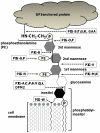Detection of PIGO-deficient cells using proaerolysin: a valuable tool to investigate mechanisms of mutagenesis in the DT40 cell system
- PMID: 22428069
- PMCID: PMC3299801
- DOI: 10.1371/journal.pone.0033563
Detection of PIGO-deficient cells using proaerolysin: a valuable tool to investigate mechanisms of mutagenesis in the DT40 cell system
Abstract
While isogenic DT40 cell lines deficient in DNA repair pathways are a great tool to understand the DNA damage response to genotoxic agents by a comparison of cell toxicity in mutants and parental DT40 cells, no convenient mutation assay for mutagens currently exists for this reverse-genetic system. Here we establish a proaerolysin (PA) selection-based mutation assay in DT40 cells to identify glycosylphosphatidylinositol (GPI)-anchor deficient cells. Using PA, we detected an increase in the number of PA-resistant DT40 cells exposed to MMS for 24 hours followed by a 5-day period of phenotype expression. GPI anchor synthesis is catalyzed by a series of phosphatidylinositol glycan complementation groups (PIGs). The PIG-O gene is on the sex chromosome (Chromosome Z) in chicken cells and is critical for GPI anchor synthesis at the intermediate step. Among all the mutations detected in the sequence levels observed in DT40 cells exposed to MMS at 100 µM, we identified that ∼55% of the mutations are located at A:T sites with a high frequency of A to T transversion mutations. In contrast, we observed no transition mutations out of 18 mutations. This novel assay for DT40 cells provides a valuable tool to investigate the mode of action of mutations caused by reactive agents using a series of isogenic mutant DT40 cells.
Conflict of interest statement
Figures




Similar articles
-
Glycosylphosphatidylinositol (GPI) anchored protein deficiency serves as a reliable reporter of Pig-a gene Mutation: Support from an in vitro assay based on L5178Y/Tk+/- cells and the CD90.2 antigen.Environ Mol Mutagen. 2018 Jan;59(1):18-29. doi: 10.1002/em.22154. Epub 2017 Nov 8. Environ Mol Mutagen. 2018. PMID: 29115020 Free PMC article.
-
Development of an in vivo gene mutation assay using the endogenous Pig-A gene: II. Selection of Pig-A mutant rat spleen T-cells with proaerolysin and sequencing Pig-A cDNA from the mutants.Environ Mol Mutagen. 2008 Oct;49(8):622-30. doi: 10.1002/em.20413. Environ Mol Mutagen. 2008. PMID: 18626996
-
The in vitro PIG-A gene mutation assay: mutagenicity testing via flow cytometry based on the glycosylphosphatidylinositol (GPI) status of TK6 cells.Arch Toxicol. 2015 Dec;89(12):2429-43. doi: 10.1007/s00204-014-1413-5. Epub 2014 Nov 23. Arch Toxicol. 2015. PMID: 25417052
-
[The PIG-A gene as a new biomarker of mutagenesis: proof of concept and technical specifications].Med Sci (Paris). 2017 Apr;33(4):432-439. doi: 10.1051/medsci/20173304014. Epub 2017 May 12. Med Sci (Paris). 2017. PMID: 28497740 Review. French.
-
Mutant cells defective in DNA repair pathways provide a sensitive high-throughput assay for genotoxicity.DNA Repair (Amst). 2010 Dec 10;9(12):1292-8. doi: 10.1016/j.dnarep.2010.09.017. Epub 2010 Oct 27. DNA Repair (Amst). 2010. PMID: 21030320 Review.
Cited by
-
The endogenous exposome.DNA Repair (Amst). 2014 Jul;19:3-13. doi: 10.1016/j.dnarep.2014.03.031. Epub 2014 Apr 24. DNA Repair (Amst). 2014. PMID: 24767943 Free PMC article. Review.
-
Glycosylphosphatidylinositol (GPI) anchored protein deficiency serves as a reliable reporter of Pig-a gene Mutation: Support from an in vitro assay based on L5178Y/Tk+/- cells and the CD90.2 antigen.Environ Mol Mutagen. 2018 Jan;59(1):18-29. doi: 10.1002/em.22154. Epub 2017 Nov 8. Environ Mol Mutagen. 2018. PMID: 29115020 Free PMC article.
-
Oxidative stress at low levels can induce clustered DNA lesions leading to NHEJ mediated mutations.Oncotarget. 2016 May 3;7(18):25377-90. doi: 10.18632/oncotarget.8298. Oncotarget. 2016. PMID: 27015367 Free PMC article.
-
Development of a novel PIG-A gene mutation assay based on a GPI-anchored fluorescent protein sensor.Genes Environ. 2019 Dec 10;41:21. doi: 10.1186/s41021-019-0135-6. eCollection 2019. Genes Environ. 2019. PMID: 31867084 Free PMC article.
-
Development of an in vitro PIG-A gene mutation assay in human cells.Mutagenesis. 2017 Mar 1;32(2):283-297. doi: 10.1093/mutage/gew059. Mutagenesis. 2017. PMID: 28057708 Free PMC article.
References
-
- Baba TW, Giroir BP, Humphries EH. Cell lines derived from avian lymphomas exhibit two distinct phenotypes. Virology. 1985;144:139–151. - PubMed
-
- Dhar PK, Sonoda E, Fujimori A, Yamashita YM, Takeda S. DNA repair studies: Experimental evidence in support of chicken DT40 cell line as a unique model. J Environ Pathol Toxicol Oncol. 2001;20:273–283. - PubMed
-
- Winding P, Berchtold MW. The chicken B cell line DT40: A novel tool for gene disruption experiments. J Immunol Methods. 2001;249:1–16. - PubMed
-
- Yamazoe M, Sonoda E, Hochegger H, Takeda S. Reverse genetic studies of the DNA damage response in the chicken B lymphocyte line DT40. DNA Repair (Amst) 2004;3:1175–1185. - PubMed
Publication types
MeSH terms
Substances
Grants and funding
LinkOut - more resources
Full Text Sources

